

European
Nuclear Society
e-news
issue 35: February 2012
The dawning of a new year traditionally ushers in a period of stock taking, of calm and objective analysis. We instinctively assess what we achieved and what we failed to achieve over the past twelve months. This necessary annual ritual forces us to question our methods, identify the lessons to be learned and redefine and restate our objectives for the year ahead. It has a therapeutic effect too, as enthusiasm is rekindled and minds are refocused. Some readers may look back on the year that was and be forgiven for heaving a huge sigh of relief that a line has finally been drawn under what some observers have called the nuclear community’s annus horribilis. The tragic events in Fukushima triggered considered political reaction across Europe. Inevitably, journalists sharpened their pencils, hammered away at their laptops and focused their TV cameras on the nuclear industry with renewed zeal. Such intensified scrutiny was both legitimate and inevitable. A decrease in public acceptance of nuclear - mainly temporary - was equally ineluctable. 2011 was, undoubtedly, a watershed year for the whole nuclear community. The need to look back in order to move forward, a classic symptom of “January syndrome”, seems to be all the more essential now that 2012 is upon us.
While for many Fukushima leaves an indelible imprint on the memory, there were also a number of significant events in 2011 that made their mark. From a political perspective, 2011 was, in many ways, the “Year of the Roadmap,” with the EC publishing its long-awaited Energy 2050 Roadmap and its much-heralded Communication, A roadmap to a low-carbon economy by 2050. These initiatives underline the significant contribution that nuclear energy has to make to the EU energy mix and to its low-carbon economy objectives. The nuclear industry contributed to policy development by publishing its own roadmap. Indeed, EU policy-makers currently produce more roadmaps than in TomTom.
But, as the two-headed Roman god Janus tells us, January is also a time for looking forward. And 2012 promises to be an equally red-letter year. Key proposals and policy initiatives that will impact, to varying degrees, on the whole nuclear community will feature prominently on the EU policy agenda. First and foremost the peer reviews that will follow on from the risk and safety assessments (stress tests) should be completed by April. They will focus on three main areas, initiating events (floods, earthquakes, etc.), the loss of safety functions (electricity supply, heat sink, etc.) and severe accident management. Following Fukushima the European Council and the EC called, not surprisingly, for an early revision of the Nuclear Safety Directive. A Roadmap on the revision of the Directive – yes, another one - will be presented by the EC. The Basic Safety Standards Directive is also due to be adopted by the European Council by the end of the year.
From a research perspective, 2012 should see discussions of the Horizon 2020 Proposal that was put forward by the EC last year progress and an Opinion delivered by the European Parliament. Horizon 2020 is a proposed R&D investment programme to the tune of €80 billion, which should cover the period from 2014 to 2018 and could provide fresh impetus to the nuclear science community’s research efforts. Other areas under the EU policy spotlight in 2012 will include radioactive waste management, the harmonisation of design licensing, long-term operation and public acceptance. Anyone who misguidedly thought that after the trials and tribulation of 2011 the new year might somehow progress at a more leisurely pace is probably in for a rude awakening. I wonder what 2012 will become known as.
This first ENS NEWS of the new decade kicks off, as usual, with the Word from the President. But this time it’s different as it comes from our new President, Marco Streit, who focuses on the past, present and future of the Society. Andrew Teller, in what will be his last regular contribution to ENS NEWS highlights the dichotomy of the traditional views of the pro and anti-nuclear schools of thought and underlines how they have inspired many of his articles over the years.
The ENS Events section underlines the busy ENS conference agenda in 2012, with PIME, RRFM, TopSafe, TopFuel and ENC topping the bill.
In the Member Societies section contributions from Belgium, Slovenia, Spain, Finland, Austria and Romania cover a range of subjects from the long-term operation of NPPs to the impact of the global population explosion on the planet’s energy needs and standards of living; from waste disposal and stress tests to knowledge management to new technological developments.
The Young Generation Nuclear (YGN) column delivers a report on how the sterling work carried out by a colleague from Westinghouse in promoting the nuclear industry in general - and the development of young people in particular - has been duly recognised, with the attribution of a special award.
In the Corporate Members section there are two contributions from both Rosatom and SCK-CEN. Our Russian colleagues feature their successful Train of Innovations mobile exhibition initiative and report on the importance of preserving the knowledge and heritage of the nuclear industry in their country. SCK- CEN reports on the significant extension of its collaborative research programme with Japan, and showcases its world première Guinevere project, the very latest in the field of accelerator driven systems (ADS).
The focus then switches to World News, with information about a special scholarship open to students wanting to study new options for the final disposal of radioactive waste. There is also a report on the contribution made by Women in Nuclear (WiN), as well as information about an IAEA/FORATOM Workshop and a JRC initiative to upgrade skills in the nuclear industry.
Let’s hope that 2012 will be equally as momentous as 2011, but perhaps for different reasons.
Enjoy ENS NEWS N° 35!
|
http://www.euronuclear.org/e-news/e-news-35/presidents-contribution.htm


To be elected President of the largest society representing the interests of Europe’s nuclear science community is indeed a great honour. To be the first elected since Fukushima is especially challenging. The inhomogeneous and polarised opinions about nuclear power that have been expressed following the catastrophe have engendered the complex and uncertain situation that we face today.
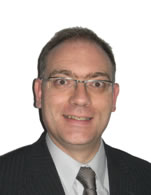 | However, a look back at the history of ENS, and a reminder of its founding values, make me confident that our community will meet whatever challenges lie ahead. ENS was founded in 1975, in Berne, Switzerland, “to promote and contribute to the advancement of science and engineering in the field of the peaceful uses of nuclear energy by all suitable means.” As a German citizen who has been working in Switzerland for twenty years now it is a special honour for me to be the second “Swiss” President of ENS, after Alain Colomb, the Society’s very first one. All his successors, up to and including Vladimir Slugen, have |
worked tirelessly to make ENS what it is today - a pan-European organisation with unparalleled expertise and competence in the field of nuclear science and technology. The ethos of ENS is the appliance of science.
I am proud to follow in the footsteps of my distinguished predecessors and intend to follow their example. I am committed, together with my colleagues on the ENS Board and the members of the High Scientific Council (HSC), to doing all in my power to further advance the aims of the Society. My main goals over the next two years are to strengthen the Society’s networking capability, to raise the profile of the work of the Young Generation, to highlight the important contribution made by committees like the HSC and, last but not least, to make being a member of ENS a worthwhile and rewarding experience.
Regardless of the decisions taken by politicians in the wake of Fukushima, many of the challenges facing the nuclear science community today remain the same as before. These include the need to raise awareness of the multiple applications of nuclear science, to increase public and political acceptance of nuclear technology and to inspire young people to invest in a career in the nuclear industry.
There are also certain what I call “base-load issues” that we need to address and communicate about more successfully – issues that have become even more pivotal in the post-Fukushima era. One of these is convincing the public that nuclear power plants and the technology that drives them are fundamentally safe. Another is persuading people that safe and effective solutions for the management of radioactive waste already exist. At the same time, I believe that we also need to focus more on the many significant success stories of nuclear science, achievements that our opponents have conveniently chosen to distance from the “centre ground” of the nuclear debate. Among these are the various medical, industrial and agricultural applications of nuclear energy that have helped to improve human health and quality of life. They have contributed directly to the well-being of mankind – and will continue to do so. Such a holistic approach to promoting nuclear science will require a lot of time and energy. But the nuclear science community is strong, with a reservoir of over 200,000 experts across Europe. That rich vein of knowledge, expertise and commitment should help us to progress from a position of passively defending the peaceful uses of nuclear science and technology to one of actively promoting them. Together, we can achieve this goal.
Marco Streit
President of ENS
http://www.euronuclear.org/e-news/e-news-35/listening.htm


Dear Reader,
Since September 2003, you have seen this column appear in each and every issue of ENS News (barring the autumn 2011 one). Its author has however come to the realisation that the main thrust of his contribution to the nuclear debate has now been amply expounded in the past articles. What was their common thread? It might be worth summarizing it here one last time. I have tried to analyse the way the debate for and against nuclear energy is conducted between two vastly different parties: the advocates and the critics of nuclear energy. The former consist mainly of scientifically-minded people, often belonging to the nuclear industry. They strive to reason accurately and to harness nuclear energy so as to enable mankind to benefit from its advantages. The latter form a loose coalition of organisations who will take any argument, however weak it is, providing it strengthens a position that appears to be preordained. This is illustrated e. g. by the fact that they are often using contradictory premises to reach the same conclusion, which indicates that the conclusion is independent from either premise. In the world of Public Relations, the scales are heavily tipped in favour of the critics, who are not held accountable for such inconsistencies, whereas the advocates are quite understandably expected to deliver.
Adding more to what has been already said along these lines would be belabouring the point.
Had I decided to put an end to this column before 11 March 2011, I would have concluded by saying that the outcome of the nuclear debate would remain forever subject to whims and fashions even if, at that time, the improving image of nuclear energy was cause for optimism. Unfortunately, since then, we have had the Fukushima accident, which leaves cause for soul-searching, if not pessimism. What is the situation today? Although the critics of nuclear energy resort to faulty reasoning most of the time, they have been proven right on one point: nuclear reactors have not yet reached the point where they can be said to be foolproof. Three Mile Island showed that the physics of nuclear power generation was insufficiently understood; Chernobyl showed that the nature of the human factor could in certain cases be inadequately taken into account; now Fukushima teaches us that even the extent of the worst possible environmental conditions can be underestimated. For sure, each of the above cases has generated appropriate countermeasures: post-TMI upgrades, WANO, reappraisal of the applicable accident analyses. One nagging question remains: have we now exhausted the range of accident causes to be integrated in the safety design of nuclear reactors? Can we now be confident that no other accident cause still remains unidentified, taking its time until it decides to strike? Although sound reasoning is an objective pursued by we advocates of nuclear energy, one of Fukushima’s lessons is that we have overestimated our capability of avoiding serious accidents. Or was it a failure to heed the warnings of Probabilistic Safety Analysis? A back-of-the-envelope calculation indicates that incurring a serious nuclear accident does not remain a remote prospect as time goes by: assuming an average number of 400 reactors in operation since 1986, 10,000 reactor-years have elapsed since Chernobyl. Let us assume again an average serious accident rate of 1 in every 100,000 years, which would be roughly applicable to Generation II reactors. Elementary probability theory tells us then that the probability of occurrence of at least one serious accident after 10,000 reactor-years of operation is equal to 0.1, which pushes it into the territory of statistical meaningfulness. In other words, it could not be expected for such a fleet to go on forever without encountering a serious hazard. My conclusions regarding the future of nuclear energy are, therefore, threefold:
Generation III reactors have been designed to feature rates for serious accident that are two orders of magnitude lower than their Generation II forebears. Had the above-mentioned fleet consisted of Generation III units, the same total of 10,000 reactor-years of operation would have led to an accident probability equal to 0.001, which leaves it as a remote possibility. This alone shows the importance of replacing Generation II reactors by Generation III ones, unless of course the former can be upgraded to meet the standards of the latter.
Even when opting for Generation III models, it is necessary to go for deterministic designs, i.e. designs that are capable of handling a serious accident no matter what, and not on a statistical basis resting on the assumption that the conditions to be handled are highly unlikely (weren’t the conjunction of a major earthquake and a tsunami high unlikely?)
Finally, let us not fall into the trap of playing the game only by the rules devised by the critics of nuclear energy. Let us not forget that what caused the Fukushima accident also killed tens of thousands of people and wiped large areas off the surface of the earth. This is not going to happen everywhere. Similarly, although cost is an issue not to be dismissed lightly, let us not forget that the cost of non-interruptible energy is going to increase steadily. This factor will continue to shed a more favourable light on Generation III reactors and make it easier for them to meet the requirement that they be no more expensive than their cheapest competitors.
Yours sincerely,
Andrew Teller
http://www.euronuclear.org/e-news/e-news-35/pime2012.htm


12-15 February 2012, Warsaw, Poland
There are less than two weeks to go before Europe’s nuclear communicators will congregate in Warsaw, from 12 to 15 February 2012, to attend PIME 2012.
The PIME 2012 programme reflects the significant challenges that nuclear communicators around the world are facing since the accident at Fukushima. The themes driving the conference debate include meeting the challenges and applying the lessons of Fukushima, as well as regaining citizens’ confidence in nuclear in the aftermath of the accident. Delegates will also be able to take part in the workshops of their choice, thereby focusing in a more practical, hands-on way on how to solve the problems they meet every day.
Among the top-levels speakers that will focus PIMErs minds will be Hanna Trojanowska, Poland’s Deputy Minister of Economy and Commissioner for Nuclear Power and Gill Tudor, Spokesperson and Head of Media Outreach at the IAEA.
It is still time to register and make sure that you are part of the PIME action!
See you in Warsaw!
http://www.euronuclear.org/e-news/e-news-35/rrfm2012.htm


18 – 22 March in Prague, Czech Republic
The next RRFM conference will be combined with the IGORR conference for 2012.
Top-expertise and knowledge from first-class scientists and industry representatives will inspire and inform the auditory and open up new perspectives in research reactor topics.
Delegates at RRFM/IGORR 2012 will discuss:
All Key Areas of the Nuclear Fuel Cycle of Research Reactors
Innovative methods in research reactor analysis and design
Utilization of Research Reactors
Medical Application in particular Moly production
New Research Reactor Projects
Research Reactor Operation, Maintenance and Safety Reassessment
http://www.euronuclear.org/e-news/e-news-35/TopSafe2012.htm


TopSafe 2012 will take place from 22 – 26 April 2012 in Helsinki, Finland. It provides a forum for addressing the current status and future perspectives with regards to safety at nuclear installations worldwide.
The conference is directed at a broad range of experts in the area of nuclear safety, including professionals from the different disciplines involved in the safety of nuclear power plants, fuel cycle installations and research reactors.
Safety and related analyses in operating nuclear power plants and other nuclear installations
Safety and Risk Assessment
Trends in nuclear safety for existing and future installations
The preliminary programme is out now. Go to www.topsafe.org for more details!
http://www.euronuclear.org/e-news/e-news-35/TopFuel2012.htm


TopFuel 2012 will take place from 2 – 6 September 2012 in Manchester, UK.
More information is available on the TopFuel 2012 Conference Website: www.topfuel2012.org.
The TopFuel 2012 Programme Committee is calling for both oral and poster presentations in the following tracks:
Operation and Experience
Fuel operating experience and performance; reliability; high burn-up fuels; water side corrosion and hydriding; stress corrosion cracking; MOX fuel performance; post irradiation data; pool-side examination; radiation effects; water chemistry and corrosion counter-measures; assembly distortion; mixed-core operation; re-use after transportation/storage.
Transient Fuel Behaviour
Transient fuel behaviour and criteria (RIA, LOCA, ATWS, power ramps …); fuel safety-related issues; pellet cladding interaction (PCMI/PCI); transient fission gas releases; cladding bursting/ballooning, pellet fragmentation/dispersal during transient events; small and large-scale fuel testing facilities; fuel behaviour under extended loss of cooling, re-criticality.
Design and Materials
Advances in fuel assembly design; fuel processing and manufacturing; cladding and structural alloy development; MOX fuel design and manufacturing; fuel design for improved thermal hydraulics, mechanical and corrosion-resistant behaviour; irradiation experience in test reactors; accident resistant fuel; fuel design optimisation for disposal; innovative fuel concepts.
Modelling
Development, verification and validation of fuel modelling codes; multiscale modelling; multi-physics coupling; fuel behaviour modelling during operation and under back-end conditions; water chemistry modelling; treatment of uncertainty; statistical analysis;design and analysis methods.
Spent Fuel Storage and Transportation
Interim storage; reprocessing; closed fuel cycles; criticality; fuel behaviour in dry containers, wet storage ponds and during transportation; long-term storage strategies; ageing; R&D activities; fuel database management.
Authors should submit their abstract text in English (a minimum of 400 words) through the Abstract Submission System on
Reference number ISBN978-92-95064-16-4 |
|---|
http://www.euronuclear.org/e-news/e-news-35/ENC2012.htm


ENC 2012 provides a platform for the nuclear science community to share their experience and to learn about the latest developments going on in nuclear research and their practical applications. It will furthermore exploit synergy among scientists, industry representatives, policy-makers and citizens on wider societal issues that impact upon how the nuclear science community carries out its work.
ENS and the ENC 2012 Programme Committee are now calling for abstracts in the following areas:
Reactor technologies
The fuel cycle
Plant operations and safety
New Build
End of Use management
Life science applications
Non-power industrial applications
Education, training and knowledge management
Nuclear in the civil society
We welcome both oral and poster submissions. If you wish to share your knowledge and take part at this prestigious event, please submit your abstract by 15 May 2012.
The abstracts received will be peer reviewed under the auspices of the ENC 2012 Programme Committee.
Deadline for abstract submission: 15 May 2012
Notification of authors: 30 June 2012
Deadline for full paper submission: 31 October 2012
Deadline for submission of PowerPoint presentations: 23 November 2012
Conference: 9 - 12 December 2012
Conference Proceedings with reference number ISBN 978-92-95064-14-0 will be published on the website of the European Nuclear Society and on www.enc-2012.org
http://www.euronuclear.org/e-news/e-news-35/bns.htm

 |
Long-term operation (LTO) is becoming more and more a routine procedure in nuclear countries and it is expected that the life of a vast majority of nuclear power plants will be extended. Regulatory frameworks, guidelines and processes are converging more and more, but peculiarities still exist from country to country, particularly with regards to environmental impact assessment, R& D evaluations, design |
upgrades, competences & knowledge management. A broad-ranging analysis of the subject of the long-term operation of nuclear power plants was the topic under the debating spotlight during a conference entitled: The long-term operation of Nuclear Power Plants: Life beyond 40 years, which was organised, on 27 October 2011, in Doel, by the Belgian Nuclear Society.
During the conference Frederik Van Wonterghem, from the Federal Agency for Nuclear Control (FANC), gave a presentation in which he outlined how the Belgian national authority has clearly defined the Regulatory Framework and its expectations. This helped Electrabel, the nuclear power plant operator, to understand what he had to do to build its “Safety Case.” Geert Backaert, of Electrabel, explained the comprehensive approach and methodology that was adopted to structurally address the FANC’s requirements and expectations, and stated that it will soon be detailed in a paper that will include the proposed Design Upgrade plan.
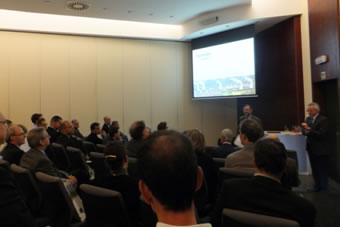
On a more technical level, delegates explored the issue of reactor vessel embrittlement. Rachid Chaouadi illustrated how R& D carried out at SCK-CEN has encouraged a better understanding of the actual mechanisms and influencing parameters relating to embrittlement. It has also helped to refine modelling techniques and promote enhanced surveillance strategy. The main conclusion reached was that irradiation embrittlement is a phenomenon that is now well under control and that the life extension of reactor vessels to 50 or 60 years is perfectly feasible and safe.
Participants in the conference were informed by Michel De Smet, of Tractebel Engineering, about “time limited ageing analysis” and, more specifically, about metal fatigue. One important change in this regard occurred recently in the regulations applicable in the US, namely relating to environmental effects and why it appears that the actual number of transients is, most of the time, lower than predicted at design stage. This new rule challenges older accepted calculations and requires the refining of modelling and calculation techniques. However, exactly how relevant consideration of this environmental effect is remains under discussion.
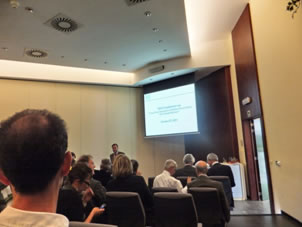
Finally, André de Jong, from the Borssele NPP in the Netherlands, gave conference delegates a presentation of the journey that they have followed to 60 years of operation, as well as of their Safety Case. The latter is quite close to the Belgian one, but has some specific additions. Similar technical issues face both the Netherlands and Belgium when it comes to meeting the challenge of extending the life of nuclear power plants.
As a conclusion, we may say that although more and more a well known process, LTO is still far from being harmonized. In general, there are no major technical concerns identified that could impair life extension. Also, significant design upgrades and investment might be required. One thing for sure is that such a Safety Case requires a major effort from the licensees. Let’s hope it will not be useless in Belgium.
Jean Van Vyve – Conference Chairman
http://www.euronuclear.org/e-news/e-news-35/slovenia.htm

|
The year 2011 was very important for the global nuclear community in general. It was particularly significant for the Nuclear Society of Slovenia, because at the end of the year it celebrated the twentieth anniversary of its foundation. The occasion was marked with the organisation of a special event. Among the guest speakers at the event were: Franc Bogovič, Major of the city of Krško, where Slovenia’s only nuclear power |
|---|
plant (NPP) is located; Ivan Špiler, Director of General Administration at the Krško NPP; Professor Emeritus, Dr. Frank Deconinck, Honorary President of the European Nuclear Society; Professor Marko Čepin, President of the Nuclear Society of Slovenia and Dr. Leon Cizelj, Head of the Reactor Engineering Division at the Jožef Stefan Institute.
Professor Čepin presented an award to the founding members of the Society in recognition of their essential contribution to its creation. Professor Cizelj, in his capacity as Chairman of the nomination committee for the Best Students Awards 2011, duly presented the awards to the winners for the outstanding work that they carried out in 2011.
The year 2011 was also a red letter year for several other reasons. Firstly, it marked the thirtieth anniversary of the first kilowatt hour of electricity ever produced at the Krško NPP. Secondly, it marked twenty-five years of postgraduate nuclear engineering study at the Faculty of Mathematics and Physics of the University of Ljubljana. Finally, Slovenia’s Agency for Radioactive Waste celebrated its twentieth birthday.
Over the years, the Nuclear Society of Slovenia has contributed fundamentally to building public acceptance of the nuclear option in Slovenia and intends to continue with its activities in the future. The main event of 2012 is going to be the 21st Nuclear Conference: Nuclear Energy for New Europe 2012, Ljubljana, which the Nuclear Society of Slovenia is organising from 5-7 September 2012. For more information about the conference, click on the following web link: www.nss.si/ljubljana2012/.
Marko Čepin
President of the Nuclear Society of Slovenia
http://www.euronuclear.org/e-news/e-news-35/hungary.htm

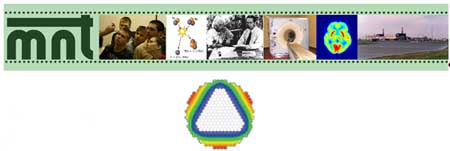
On 1 and 2 December 2011, the Hungarian Nuclear Society (HNS) organised its annual Symposium on Nuclear Techniques, in Budapest. The Symposium was the 10th in a series of annual national scientific meetings. The main aim of these symposia is to disseminate among the members of HNS data relating to the application of nuclear techniques in different areas. This year the Symposium included sessions (plenary sessions and round table discussions) on the following subjects:
Nuclear knowledge management
Fusion research
Fukushima events and lessons
Paks NPP stress test results
Other miscellaneous topics
Representatives of other energy-related civil organisations, for example the Hungarian Energy Society, the Hungarian Electro-technics Society, the Hungarian Society for Energy Utilisation and Energy and the Energy Council, informed members during the round table discussions about Hungary’s National Energy Strategy and how nuclear will play a key role in it for the next 20 years. There was general consensus that future cooperation between the Hungarian Nuclear Society and the other partner organisations should be further developed.
The Symposium was attended by about 100 nuclear experts from Hungary, including colleagues from the utility, from the regulatory body, from engineering companies, from R&D institutions and students from grammar schools and universities.
http://www.euronuclear.org/e-news/e-news-35/population.htm

In post-Fukushima France the often heated debate about the future of nuclear energy has intensified. As a contribution to this debate our friends at SFEN have written a report dispelling many of the myths and much of the misinformation surrounding nuclear energy. The report articulates thirty simple messages about the essential role that nuclear energy plays in the energy mix – both in France and beyond. French-speaking readers, as well as those with a good grasp of the language of Voltaire and Jean-Jacques Rousseau can contact SFEN (Francis Sorin) for the whole report.
In the meantime, ENS NEWS has translated two of them in order to give its readers a flavour of the report’s content, to illustrate how the nuclear debate is shaping up in France and outline some of the messages in favour of nuclear that can be articulated. And here they are (Editor-in-Chief).
In the coming years the world will have to satisfy an ever-increasing demand for energy. Today, there are 7 billion inhabitants on planet earth. By the year 2050, there will be 9 billion of us, maybe more. So, if we want to keep pace with this growth in population and improve access to energy for the most disadvantaged of populations, we will need to ensure production of energy on a far greater scale than we do at present. Today, 4 billion people suffer from energy poverty; 1.5 billion don’t even have electricity.
All this means that even if we, the rich nations, (around 1 billion on the world’s population) manage to make spectacular energy savings - for example by halving our current level of consumption - we will still have to produce much more energy than we are today - especially electricity, which is essential for economic development.
In the emerging nations millions of people each year are benefiting from a better standard of living. The first thing that they do in response is buy themselves a refrigerator, a television, a washing machine, an iron, etc. In other words, they bring about a dramatic increase in electricity consumption. Indeed, almost all economic forecasts predict a doubling of this consumption by the year 2050. This fact provides a very persuasive argument for increasingly turning to nuclear energy. Renewable energies will have an important role to play too. But their contribution will be nowhere near sufficient, especially since some of them, like wind and solar, are intermittent sources that can only generate electricity for 25% of the time. Nuclear energy is, therefore, a significant asset when it comes to meeting the world’s rapidly increasing need for electricity.
Since 2001, Germany has been officially committed to the early (2020) abandonment of its nuclear programme, in accordance with its so-called “phase-out” law. In 2010, with the phase-out process barely underway, the 17 nuclear reactors in operation in Germany generated 22% of the country’s electricity. On 6 September 2010, the government of Chancellor Merkel officially decided to delay the phase-out the operation of the reactors by an average of 12 years.
On 20 March 2011, one week after the accident at Fukushima occurred, and well before any of the lessons of the accident had been properly learned, the German government decided to “temporarily” shut down 8 reactors. By May 2011, it had reversed its earlier decision and confirmed that nuclear would be abandoned by 2022 and the 8 reactors in questions would be definitively shut down.
Paradoxically, in France many people urged the country to follow the example of its neighbours on the other side of the Rhine, as if Germany had suddenly become an example to follow when it comes to environmental protection! But Germany’s environmental sensitivity is, to say the least, ambiguous. For example, it is preventing the rest of Europe from developing hybrid car engines.
Our neighbours to the East have undoubtedly invested a considerable amount of money in developing wind and photovoltaic energy sources, but the renewable energy tree hasn’t managed to hide the fossil fuel forest. In 2010, 42% of Germany’s electricity was still being produced by burning fossil fuels, more often in the form of imports from Poland or domestic supplies of lignite. This made Germany far and away the largest producer of greenhouse gases in the EU. The phasing out of nuclear will only worsen the situation.
International Atomic Energy Agency (IAEA) statistics for 2009 |
||
|
France |
Germany |
Total CO2 emissions, energy linked (Million tonnes) |
354 |
750 |
Tonnes of CO2 per inhabitant |
5,49 |
9,16 |
Kg of CO2 per $2000 of GIP |
0,24 |
0,38 |
Not only is lignite extremely polluting when burnt, it is also extracted from enormous opencast mines. To expand this production 45,000 people will have to be evacuated and 18 villages will need to be destroyed over the next fifteen years. And yet this situation is met with general indifference.
Furthermore, this hasty decision was taken without any consultation with Germany’s neighbours or partners in the EU, all of whom have already been affected by it. The new level of CO2 emissions in Germany will damage the chances of Europe meeting its emission reduction target of 20% by 2020.
An increase in German imports of Russian gas will increase prices for everyone, as well as our energy dependence. From being a former net exporter of electricity, Germany has now become a net importer of electricity, primarily from France, Poland and the Czech Republic. It is ironic to note that a large part of this imported electricity comes from the nuclear sector!
This phase-out will be very expensive, but German consumers as a whole already pay much more for their electricity than their French counterparts and the shock for private individuals will be attenuated. German industry, on the other hand, is already threatening to relocate its electricity-intensive activities elsewhere.
Price of electricity in 2010, calculated in € centimes/kWh (inclusive of taxes) |
|||
|
France |
Germany |
EU average |
Companies |
8,01 |
12,28 |
11,0 |
Households |
11,91 |
23,60 |
16,61 |
Source: The Commission for Sustainable Development, September 2011
http://www.euronuclear.org/e-news/e-news-35/finland.htm

On 3 November 2011, the Finnish Nuclear Society (ATS) organised its traditional autumn seminar at the “House of the Estates”, in Helsinki. Altogether 149 members of the Society participated in the seminar.
Tellervo Taipale, from FORATOM, gave an overview of the effects of the Fukushima accident on European nuclear policy. Keijo Valtonen from STUK described the influence that Fukushima had on nuclear safety legislation. Janne Mokka from TVO and Kai Salminen from Fennovoima gave an update on the new nuclear power plant (NPP) projects. Harri Tuomisto from Fortum presented data specific to Fortum's NPPs.
The presentations are available, in Finnish, on the ATS web page.

Tellervo Taipale from FORATOM gave an overview of the effects of the Fukushima accident on the European nuclear policy in the autumn seminar of ATS.
That evening ATS celebrated its 45th anniversary at the Palace Gourmet Restaurant, in Helsinki, together with 108 members of the Society. At the event Risto Tarjanne and Jussi Manninen were nominated new honorary members of the Society. Professor Riitta Kyrki-Rajamäki, from the Lappeenranta University of Technology, was the honorary speaker for the event.
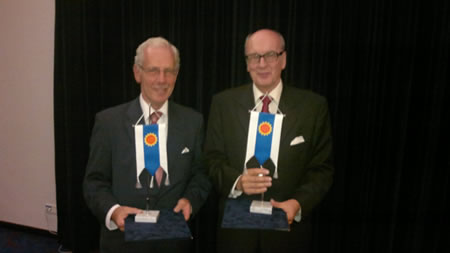
Risto Tarjanne and Jussi Manninen are the new honorable members of ATS.
ATS continued its tradition of organizing annual excursions with a visit to Japan from 19 to 27 November. During the one week tour, ATS members visited the Japan Atomic Industrial Forum (JAIF), the reactor vendors Hitachi-GE and Toshiba, NPPs in Hamaoka and Takahama, and Mitshubishi Heavy Industry factories. The tour ended with a visit to the beautiful town of Kyoto. 17 members of the society participated. ATS wishes to thank JAIF and the host organisations for their hospitality and for their help in arranging the tour.
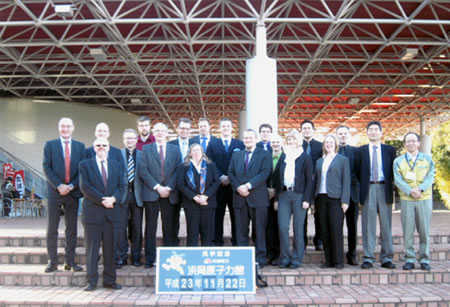
The ATS delegation in Japan
http://www.euronuclear.org/e-news/e-news-35/raan-siton.htm

In recent years, RAAN – SITON, a subsidiary of Technology and Engineering for Nuclear Projects and a major contributor to Romanian investments in the nuclear field, has concentrated its focus on a new field of research – the development of challenging path-related deep geological disposal of radioactive waste.
This approach, not surprisingly, exploits fully the enthusiasm, commitment and professional skills of all researchers involved in the development and application of technical solutions for radioactive waste management in Romania. The strength of the organisation consists in its cooperation and continuous upgrading of the knowledge of the existing workforce, as well as in the continuous training and support that it provides for personnel with regards to future projects.
The National Radioactive Waste Management Strategy, which was developed by what used to be ANDRAD (today called AN&DR), has been integrated into the National Nuclear Policy and is supported by regulators, scientists, designers, technological engineers.
RAAN – SITON, in cooperation with other research institutes and regulatory bodies, has launched a new research initiative related to the safe final disposal of spent fuel and high-level waste. In 2008, SITON developed an R&D programme, coordinated by AN&DR, focusing on deep geological alternatives. This research was financed by the Ministry of Economy and Finances and carried out as part of a regional R&D programme.
Romania is a small country with a high population density. This fact, together with Romania’s rich array of natural resources (oil & natural gas deposits, mineral ores, geothermal waters, forests etc.), could present difficulties when siting a geologic repository, and many apparently acceptable locations have had to be excluded from the selection process - even when they satisfied the IAEA selection criteria for host rock formation. SITON, together with other partners, were pioneers in efforts made to identify a portfolio of host rock formations for a national final repository for spent fuel and long-life wastes.
The organisation produced documentation based on the research of specialised literature in order to emphasise the necessity for consistent R&D programmes aimed at finding appropriate locations for a Geologic Repository (GR) and identifying the most favorable host rock formation. Even though research into geological environments’ suitability for final disposal of spent fuel and high level wastes is still in the early stages, RAAN – SITON and its partners anticipated that there would be issues of considerable interest to consider for the demonstration of a conceptual design for a GR. So, RAAN – SITON is a supporter of the development of an underground laboratory capable of performing large scale experiments into potential host rock formations in order to demonstrate the suitability of a final deep geological repository.
Because there are many specific constraints in Romania (geological, economic, demographic, etc.), RAAN – SITON took into account other designers’ experiences in countries with old nuclear programmes and considered the option of waste “co-localisation.” Accordingly, researchers from SITON are involved in a study into the possible long-term evolution of a disposal facility for spent fuel and long-life radioactive wastes that anaylses scenarios involving possible chemical alteration in both the neighbouring and wider environments. For these scenarios it is necessary to develop mechanical and kinetic models in order to study if any impairment exists to the long-term serviceability of spent fuel canisters or if there are any other engineering/natural barriers.
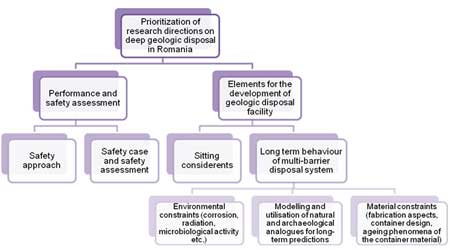
The data obtained was considered valuable as a preliminary input for selecting container materials to be used in an intended Romanian deep geological repository. So, research activities in support of deep geological disposal in Romania have been extended to include the integration of natural analogues, archaeological data and geological mapping data in order to facilitate a final decision and to help with the extrapolation of the long-term serviceability of engineered barriers.
RAAN-SITON is recognised by the Romanian Nuclear Authority (CNCAN) as a national organisation specialised in carrying out design activities and other kind of services, including research and development projects for other nuclear projects in Romania. RAAN-SITON also guarantees a high level of professionalism, efficiency and competence.
Author: Raluka Fako, PhD, Eng., Romanian Authority for Nuclear Activities, Subsidiary of Technology and Engneering for Nuclear Projects
http://www.euronuclear.org/e-news/e-news-35/sne-news.htm

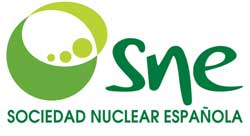
Following the second cabinet meeting of the new Spanish government’s Council of Ministers it was decided to locate the Temporary Centralized Storage facility in Villar de Cañas, a farming town of 1,000 inhabitants located in the province of Cuenca, 135 kilometers southeast of Madrid. The project will require an investment of 750 million euros and will create 300 direct jobs.
Meeting the deadlines imposed by the European Union, Spanish nuclear power plants (NPPs) submitted their final reports on the stress tests to the Nuclear Safety Council (the Spanish regulatory body) on October 31. The regulator had previously evaluated these reports before December 31, in keeping with the deadline for drawing up and consolidating the national reports in the various Member States.
The scenarios analysed in this complementary reassessment of the beyond design basis safety margins basically included the following:
Earthquakes, floods and other extreme natural events
Loss of safety functions due to loss of electric power supply and loss of the final heat sink (cooling capacity)
Management of severe accidents occurring in the reactor core and in spent fuel repositories
The results of the national report reveal that not only is there compliance with the design bases stipulated for each installation, but that there are also additional margins that ensure the maintenance of safe plant conditions in the face of any extreme events that may be postulated beyond the said design bases.
The Nuclear Safety Council also gave a very positive opinion on the fact that the plant owners have additionally proposed certain improvements in both equipment and resources in order to increase even more existing safety margins, as part of Spanish NPPs’ commitment to continuous improvement from the very beginning of operation.
The Ministry of Industry, Energy and Tourism (MINETUR) asked the Nuclear Safety Council whether there is any impediment, in this regulator’s opinion, to modifying the Ministerial Order dated July 3, 2009, which agreed upon July 6, 2013 as the date of definitive cessation of operation of the Santa Maria de Garoña NPP and authorised its operation until that date.
The ministry has also requested the CSN to issue a report on the limits and conditions that, should the ministerial order be modified, it deems advisable to stipulate for such modification, in order to leave open the possibility of renewing the current operating license for a further period of six years as of its expiry date.
In July 2009, the CSN considered that Garoña NPP met the requirements for renewing its operating license until 2019. However, the government decided to ratify its closure on July 6, 2013. One of the first decisions of the new Government, which won the November elections, was to consider the possibility of extending plant operation until 2019.
http://www.euronuclear.org/e-news/e-news-35/kit.htm

Key factors relevant for sustainable nuclear energy are related to the optimization of resources utilization, the solution for the waste treatment and the reduction of waste generated per unit of electricity produced. Moreover, economy, efficiency and proliferation resistance are additional important factors addressed within the new generation of nuclear systems and advanced fuel cycles.
The objective of the seminar was to show the essential bricks needed to implement innovative nuclear power in advance fuel cycles to reach the above state goals. The seminar has been built by considering multidisciplinary challenges that are encountered in the main technological areas, i.e. reactor physics, thermal-hydraulics and safety, structural and fuels materials, separation and actinide chemistry and geochemistry and advanced modeling in the different field.
The contributions did address the new challenges and frontier research has been illustrated in all the major technical fields mentioned above. More general and strategy-oriented lectures were also included in the program, in order to provide a wider perspective, also from the European point of view.
From the lectures and the numerous debates that have taken place, with the participation both of the lecturers and the young scientists, it has emerged that fast neutron reactors are reference solutions to address the nuclear energy sustainability due to their core design flexibility, which can be tuned as breeder and/or burner of actinides. The implementation of these systems in advanced fuel cycle implies also advancement in the field of actinide chemistry. Innovative actinide partitioning processes, where the separation strategies of the actinides with new molecules (in case of hydrochemistry) and with advanced electrochemical methods (in case of pyrochemistry) have been discussed. Moreover, the challenges faced in the field of new fuel fabrication, new materials, coolant thermal-hydraulics and reactor physics have been extensively discussed. Finally, it has been reminded that a final repository is mandatory, whatever strategy is implemented. The reduction of the amount of actinides send to the repository will certainly reduce the burden on it, but will never eliminate the need for it.
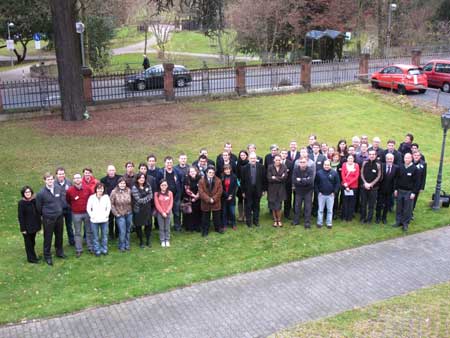
From the presentations and discussions it has emerged that the plan for implementation of advanced fuel cycles with fast neutron reactors might be different in the different world regions. For instance, alternative solutions such as small modular reactors have been as well addressed, where the economic aspect, in terms of investment cost and the potential shorter licensing delays seem to be rather relevant.
A further important outcome of this seminar has been that sustainability has to be associated to enhanced safety requirements and improved robustness of technologies.
Finally, lively discussion have been emerged from the speeches addressing strategic aspects as for instance the trend of acceptance of nuclear energy from the early fifties of the last century until today; the views of implementing nuclear energy and renewables in an energy mix to reduce the emission in the atmosphere of pollutant gases.
The lectures have been given by 21 internationally re-known experts coming from eight countries (Germany, France, US, Japan, Czech Republic, Belgium, Spain and Austria) and the seminar was attended by forty young scientists. The interests and expertise of the lecturers have triggered exchange of views and discussions that took place after each presentation with an excellent interaction among young scientists and experts.
Finally, the participants had a chance to present their current activities within a very interactive poster sessions and best poster prices have been awarded to Raffaele Bencardino from IRMM-JRC for his work on “4π detection system for the measurement of the 6Li(n,α)3H reaction cross-section”; Carole Babelot from FZJ for her work on “Conditioning of minor actinides Conditioning of minor actinides in La-Monazite-type ceramics” and to Barbara Vezzoni from KIT for her work on “Analysis of transition nuclear fuel cycles from LWRs to Gen-IV reactors”.
The Seminar is kindly and generously funded by the Wilhelm and Else Heraeus Foundaton. The Foundation is a private in-stitution which supports scientific research and education with emphasis on physics. More information is given at: www.we-heraeus-stiftung.de.
The program of the seminar, the lectures and the presented posters are available at the link: www.nuklear.kit.edu/88.php.
Contact: Concetta Fazio KIT-NUKLEAR (concetta.fazio@kit.edu) and Joachim Knebel KIT-CSO.
http://www.euronuclear.org/e-news/e-news-35/westinghouse-award.htm

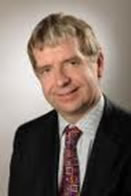 |
Last December, Adrian Bull - Head of Media & Stakeholder Relations for Westinghouse in Europe, Middle East & Africa – was named by the UK’s Young Generation Network as the 2011 recipient of their Outstanding Contribution Award. The award is presented annually by the YGN – part of the UK’s Nuclear Institute – to a person whom they consider has made an outstanding contribution to the industry, with particular focus on the development of younger people and support for YGN activities. |
Making the announcement at the Annual Dinner of the Nuclear Institute and Nuclear Industry Association (NIA), Connor Deehan of NUKEM technologies, who is this year’s YGN Chairman, said:
“Adrian has always been more than willing to present at our events, engage with our members, share his knowledge and provide all around support to the YGN. He’s always encouraged younger members to get involved and has been described as “a modern man” of the industry - approachable by all. His enthusiasm for all aspects of the industry has been an inspiration across the YGN committee. I am delighted to announce Adrian as the 2011 winner of our Outstanding Contribution Award and I would like to personally thank him for his tremendous assistance this year, including his participation in many of our seminars and Rough Guide events.”
“The YGN is a fantastic organisation, and it’s clear to me that the talented and enthusiastic people in the YGN are among those who are key to securing a successful long-term future for the UK’s nuclear industry. I’m lucky that Westinghouse has always been exceptionally supportive of YGN and have encouraged my participation in many YGN events over recent years. To be recognised through this award is incredibly flattering and I am very proud and honoured to receive it. I look forward to working with YGN for many years to come.”
For further information on this or other news from Westinghouse visit the Westinghouse’s web site at: www.westinghousenuclear.com/
http://www.euronuclear.org/e-news/e-news-35/Sck-cen.htm

SCK•CEN and its Japanese counterpart, JAEA, recently agreed to continue to work together in close cooperation for the next five years on a number of specific nuclear research projects. A collaboration agreement confirming this was signed on 4 January 2012, in the presence of H.E. the Ambassador of Japan in Belgium, Mr. Jun Yokota.
SCK•CEN has been working closely for many years with its Japanese colleagues. In 2006, an initial formal cooperation agreement was signed and that agreement has now been formally extended for a further 5 years. JAEA and SCK•CEN will work intensively together in the three following fields of research. Firstly, they will continue to collaborate on accelerator driven systems ADS, an area in which both parties have been actively involved for some time. SCK•CEN has been carrying out ADS research within the framework of the MYRRHA project and now JAEA and SCK•CEN will pool their resources to work on the design of ADS installations. The other fields of cooperation covered by the agreement are research into materials testing and the use of lead-bismuth for cooling research reactors.
Furthermore, SCK•CEN and JAEA have decided in the future to use their research reactors for common projects. The main focus here is on the implementation of advanced materials testing, such as the MIKADO project, in which the properties of reactor materials are tested. In addition to carrying on with a number of existing projects, new programmes have also been set up involving SCK•CEN's Belgian reactor 2 (BR2) and Japanese research reactors.
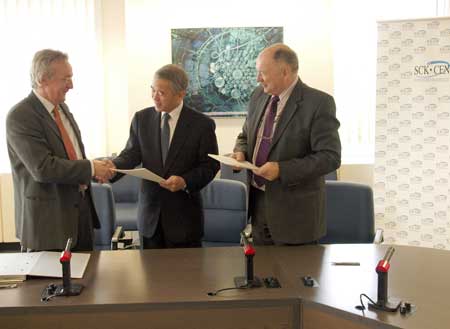
From left to right: Professor Eric van Walle, Director-General of SCK-CEN; H.E. the Ambassador of Japan in Belgium, Mr. Jun Yokota; Professor Frank Deconinck, Chairman of the Board of Governors of SCK-CEN
Finally, close collaboration will also continue on the decommissioning and dismantling of nuclear installations. Thanks to the experience it has gained with the dismantling of the BR3 reactor in Mol, SCK-CEN has acquired unique expertise in this area.
FOR more information is available on the SCK-CEN website at: www.sckcen.be
http://www.euronuclear.org/e-news/e-news-35/l3.htm

L-3MAPPS, the world leader in the delivery of nuclear power plant simulation for training operators (www.L-3com.com/MAPPS), has developed a novel product called a Learning Simulator that provides the solution when it comes to increasing the benefits to be had from using high-fidelity simulation methods to teach students about the components, systems and fundamental operational behaviour of a nuclear power plant.
By combining 3-D visualisation with high-fidelity simulation the Learning Simulator creates a learning environment that uses mathematical computer simulation as a driver for illustrating nuclear plant operations and for reinforcing the theoretical concepts taught in the classroom while at the same time introducing students to the operating controls used in a nuclear power plant. The visualisations are easily reconfigured to address specific learning objectives in a step-by-step approach that increases students’ knowledge in a systematic way. Here is some more detailed information about the Learning Simulator.
The most typical nuclear training programme currently in use around the world is composed of learning technologies and methodologies that were developed and refined in the 1980s. A typical training programme structure consists of:
Classroom fundamentals characterised by text books, lectures and PowerPoint presentations
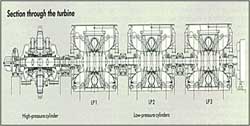 |
 |
Plant visits allowing students to see actual power plant equipment
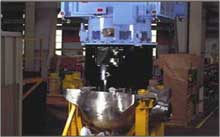 |
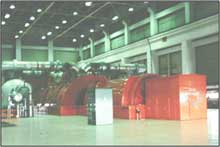 |
Full Scope Simulators duplicate control rooms with detailed mathematical modeling of all plant systems.
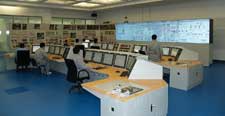 |
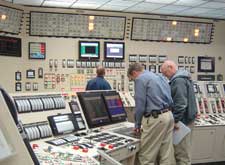 |
Training professionals clearly acknowledge that simulator training is the most effective learning phase among the three methodologies. Simulator training allows “on-the-job training.” The educational community has ranked learning techniques as shown in the learning pyramid, below. “On-the-job training” greatly improves student retention.
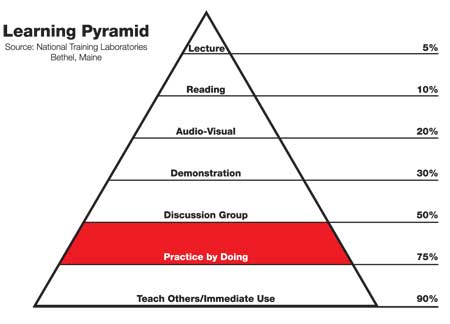
The simulator is the final step in the training process for two main reasons:
The reference power plant simulator is designed while the new build power plant is still in the design process
Students must understand the many physical systems, processes and their interactions before training on complex plant procedures can be productive and effective.
L-3 MAPPS has received suggestions from colleges and utilities targeting the training of new students in basic nuclear power plant concepts. In their opinion, full-scope simulators provide too much information and detail when a new student is first mastering fundamental concepts. This is the equivalent of studying about flying in the classroom and then attempting to fly a 777 or an A380 for the first time. In the aviation industry, a gradual process of learning to fly begins with smaller basic aircraft and flight simulators the complexity of which gradually increases over years.
Furthermore, new students are technologically savvy and expect to use technology at all stages of their training.
To resolve these dilemmas, L-3 MAPPS has devised a solution that addresses all of these issues and provides for the use of “on-the-job training” earlier in the conventional training cycle. L-3 MAPPS has coupled computer visualisation technology (Bridgeworks) with high fidelity simulation to bring real-time, simulation-driven, animated physical systems allowing immersive, participatory learning in the classroom. With this innovative approach to training, L-3 MAPPS is making it possible to increase student retention rates by making the learning experience that is typical at the top of the learning pyramid much more interactive and efficient. The overarching goal is to provide a rich training environment in which students can interact, discover and retain knowledge more efficiently.
L-3 MAPPS has developed the Learning Simulator. The Learning Simulator may be used at the beginning of and during a training cycle to increase the effectiveness of the training programme, improve retention and complete the training in less time than that taken by traditional methods.
The Learning Simulator has the authenticity of a full-scope simulator. It can be operated from a virtual control room using touch screen plant controls or from dynamic plant system representations. The Learning Simulator experience can be instructor-led and/or delivered at each student’s individual place. In addition, simulator and student response data can be automatically collected, plotted, archived and analysed.
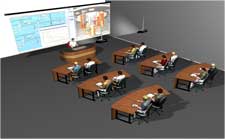 |
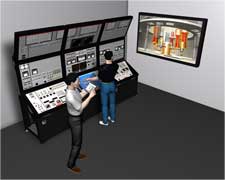 |
Where full-scope simulators are focused on training students in how to operate nuclear plants, the Learning Simulator is designed to instruct students in components, systems and fundamental operational behavior. The visualisations are easily reconfigured to address specific learning objectives in a step-by-step approach that builds students’ knowledge in a systematic way.
The Learning Simulator provides a learning environment that uses mathematical computer simulation as a driver for illustrating nuclear power plant operations and reinforcing the concepts presented in a classroom while at the same time introducing the operating controls of the nuclear power plant. It is a blend of 2-D and 3-D animations coupled with typical nuclear power plant controls. The objective is learning about “how something functions” versus “knowing what switch to turn and when.”
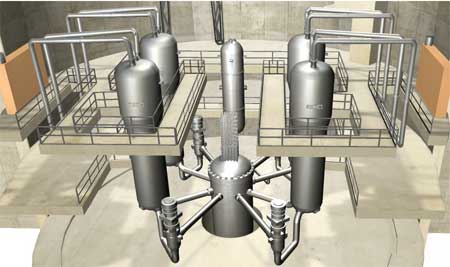
While advanced plant systems knowledge is transferred most effectively with the simulation-driven Learning Simulator, it is equally valuable for component-level or fundamental training. The student can not only see the physical configuration and their operating purpose but can also look inside specific components and learn about their inner workings.
The external casings can be dissolved, rotated and zoomed to display the inner workings of components. Not only are the components identified, but the physical operation is animated, avoiding the difficult task of trying to mentally picture equipment operation from a traditional static 2-D presentation.
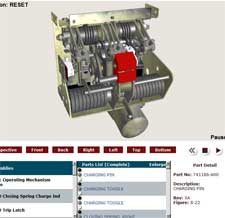 |
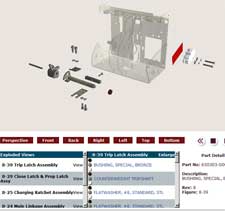 |
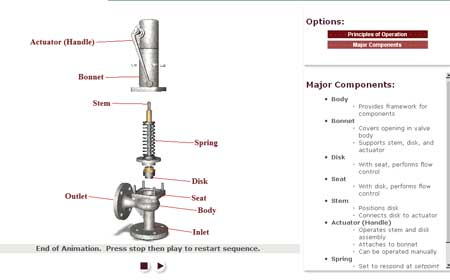
The properties calculated by the simulation models are used to drive the dynamic elements of the 2-D and 3-D models, where the different properties are displayed in relation to a working animated component. Physical properties such as temperature, enthalpy, pressure, etc. are displayed as colour gradients within 3-D plant components themselves, allowing students to easily visualise and understand thermal-hydraulic processes.
Students can also see physical operation as opposed to hearing or reading a description which they would then in turn have to translate into a working model in their mind.
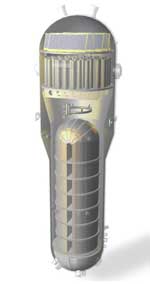 |
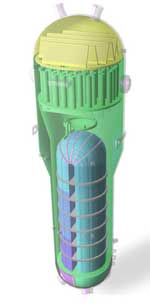 |
Training and learning are fundamentally the communication of concepts and the transfer of knowledge. We effortlessly recall images and experiences that we have witnessed. All of these truths support this type of learning medium.
The experiences gained through the Learning Simulator are invaluable and are often logistically unavailable to the student. The Learning Simulator is all about improving the “efficiency of learning” for new nuclear power plant workers.
Other important attributes:
Interesting, engaging and effective learning with more content than traditional training approaches
Imparts knowledge in minutes instead of hours
Improves subject matter retention
Encourages independence and self-reliant learning
http://www.euronuclear.org/e-news/e-news-35/rosatom.htm

In August 2011, a unique project was launched in Russia, called the « Train of innovations». It is a mobile exhibition and lecturing complex created in partnership with some of Russia’s leading companies, including JSC «Russian Railways», the Rosatom State Corporation and JSC «Rosnano».
The train consists of eight exhibition and three auxiliary wagons. Each individual exhibition is located in a separate wagon and represents the innovative developments of each participating company. When creating the concept, the project’s designers used the experiences gained from similar international projects, for example the one in India, where a similar train was launched several years ago. Another example is the one in Germany, where a number of mobile “nanotrucks” were launched displaying various innovative technologies.
Rosatom’s exhibition train is divided into three thematic units. It highlights the company’s latest achievements, provides detailed information about radiation safety rules and radiation sources and gives an historic overview of the nuclear sector.
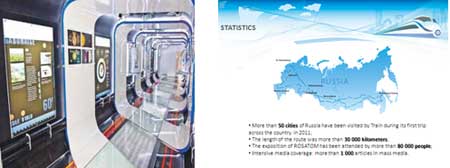
Inside one wagon is a universal radiometer, which has been placed there to enable visitors to measure the radiation level of their own body. On the walls monitors have been installed that broadcast reports from various places in the world haracterised by a high level of natural radiation – such as the monazite sands at Guarapari beaches, in Brazil, and the coastal territories of India’s Kerala State.
The central part of the exposition is devoted to safety systems installed at nuclear power plants. Animated models show the main security systems in place and spotlight Russia’s know-how in this field, in particular the operation of a melt trap.
By 2012, the train had completed two journeys via 75 towns and cities in Russia. The exhibition was visited by 80,000 people. The train crossed Russia from its capital up to the coast of the Pacific Ocean and back, covering a total of some 30,000 km of railroad track.
Residents in Russia’s megacities, such as Moscow, Saint Petersburg, Novosibirsk, Ekaterinburg, Nizhny Novgorod, Kazan, Chelyabinsk and many more, were given a unique opportunity to familiarise themselves with the innovative developments of the participating companies and received comprehensive answers to all of their questions. The train was also visited by state officials, including governors and mayors. “The exhibition created a strong impression”, commented Sergey Komyakov, Vice Governor of Chelyabinsk Region. “The cooperation of the Alliance of Russian Railways, together with the state corporations Rosnano and Rosatom, proved to be quite an interesting one as all the exhibits are related to the present day priorities of the whole country” added Mr. Komyakov.
The Train of Innovations stimulated interest from both professionals and citizens in each and every town and city visited. Both children and adults were enthusiastic about exploring the exhibition area, which often received over 1,000 visitors a day. In some cities, the number of people willing to see the hit was even too big to accommodate all of them.
The project does not end in 2012: it is to be implemented in new towns and even other countries. In due course, the train will cross Russia’s borders and visit the Ukraine, Belarus, Mongolia, Kazakhstan, Finland and the Baltic states.
At the beginning of 2012, the train is scheduled to visit the Northern Caucasus and its major towns Novorossiysk, Makhachkala, Vladikavkaz, Grozny and others. Considering the tremendous amount of public interest that has been raised by the project, the route is organised taking into account as many towns and settlements as possible in order to cover a maximum amount of localities. There is enough time to achieve this as the implementation of the project is only limited by the “in-commission time” of the rolling stock – in accordance with existing regulations, that is some 60 years!
http://www.euronuclear.org/e-news/e-news-35/legacy-nuc-industry.htm

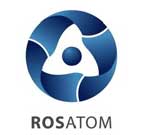 |
Rosatom, Russia’s largest company operating in the nuclear energy market, takes very seriously the preservation of the tremendous cultural and historical legacy that the country has accumulated throughout the 65-years that it has been implementing the “Soviet Nuclear Project”. “At present, the issue of the foundation of a National Museum of Power Engineering is being considered at the level of the federal government. An important element of it |
would be an exhibition devoted to nuclear power engineering and industry”, Sergey Novikov, Director of Communications Department at Rosatom, said recently.
The National Museum of Power Engineering is to be located within the All-Russian Exhibition Center (former Exhibition of People’s Economic Achievements, the largest exhibition complex during the Soviet era, which is situated north-east of Moscow).
The Museum’s exhibition will be hosted in a specially designed and constructed building that will cover a surface area of about 9,000 m2. “We want the museum’s concept to include advanced technologies and be as interactive and understandable as possible for a wide range of visitors - from pre-school children to elderly citizens”, says Nikolai Doronin, Rosatom’s Museum Programme Coordinator. “In creating the concept, we are interested in using the experience and capabilities on offer from specialised programmes developed by international companies. If they find the proposal interesting, they would be given an opportunity to tender for the concept and provide an architectural model for the museum, which is to be announced in the first quarter of 2012”, according to Mr. Doronin. The Power Engineering Museum will be positioned as a centre for cognitive leisure-time activity for the whole family and follow an “edutainment” format.
In addition, Rosatom is also planning activities aimed at preserving and developing the historical legacy of the industry, which is a valuable global asset. First of all, a list of such historical products and facilities includes the Lenin, the world’s first nuclear icebreaker, and the first nuclear power plant, which was built in the town of Obninsk, in the Moscow Region.
“We believe that nowadays both these “facilities” symbolise not so much the industrial power of the Soviet empire, but rather unique facilities that are part of our global engineering heritage”, says Sergey Novikov. “Therefore, rather than developing them on our own, we would prefer to invite as many interested parties as possible to discuss the future of the concept. First of all, I refer to our European colleagues. For these purposes, we are planning to hold a large-scale conference this year and to invite potential partners and donors to participate”.
It is worth noting that the icebreaker Lenin, which is moored in the municipal port of Murmansk, hosts a Rosatom information center and a permanent Kola Atom exhibition set up in partnership with the TASIS Program. Within the next 20 years, the Obninskaya nuclear power plant will be classified as a “radioactively hazardous facility”, according to international legislation. However, today it features a temporary exhibition and in 2012, Rosatom plans to create - in an Obninsk museum - a permanent and comprehensive exhibition space devoted to the history of the plant and how it developed over the years.
In the short term, a non-commercial foundation will be set up as the administrator of all Russian museums devoted to nuclear industry. Initially, Rosatom will be its largest donator. However, in the future the foundation will raise non-sectoral funds from partner organisations and donors to museum projects in the Russian nuclear industry, including international companies.
http://www.euronuclear.org/e-news/e-news-35/Sck-cen-2.htm


A: Prof. Dr. Peter Baeten: As a researcher, I find it important to seek solutions to societal issues. The disposal and reduction of nuclear waste, which will also burdens future generations, is an issue that is very much alive in our society. The development of ADS technology enables the transmutation of long-lived nuclear waste. This means that we can reduce greatly the quantity and radio-toxicity of this waste. In this way we also decrease the time required for underground storage from several hundred thousand years to less than 1,000 years. The research that we perform today therefore provides a valuable contribution to a viable and sustainable future for ourselves and our children.
A: Prof. Dr. Peter Baeten: GUINEVERE is the result of excellent and efficient teamwork, both within SCK•CEN as well as with various international partners. By current standards within the nuclear sector, this project has been realized extremely quickly. The former VENUS facility was only shut down in April 2007 and less than three years later we inaugurated GUINEVERE. This is largely due to all the employees who have worked to optimize co-operation across different disciplines. Within SCK•CEN, the expert group "Nuclear Systems Exploitation" took the lead in the development of GUINEVERE. They were closely supported by their colleagues from "Nuclear Systems Physics" for neutron calculations and by the "Design and Engineering Office". In addition, we could rely on the "Central Technical Services" for the construction of the facility, on "Physical Control" for the safety studies and finally on the Purchasing Department. I would like to thank all these colleagues for their efforts in realizing GUINEVERE. I also want to acknowledge the company Vanhout nv of Geel, without whose efficient cooperation the facility could not have been built so quickly.
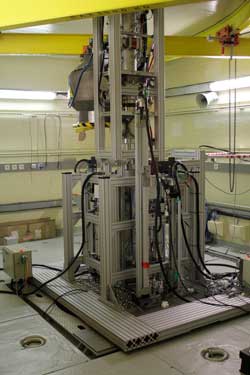 |
A: Prof. Dr. Peter Baeten: The experiments are conducted within European Framework Programmes which focus on the transmutation of long-lived nuclear waste in an ADS. Ten research institutes from different countries are participating in GUINEVERE. One of our key partners is the Centre National de la Recherche Scientifique (CNRS). They developed and built the Genepi-3C accelerator on their site near Grenoble and prepared it for transportation to SCK•CEN in 2009. CNRS employees also helped with the installation of the accelerator in the VENUS installation. The Commissariat à l'Energie Atomique et aux Energies Alternatives (CEA) in Cadarache helped us with the concept and infrastructure of the reactor and supplied the uranium fuel. Other partners include the German KIT and FZD, the Swedish KTH, the Italian ENEA and the Spanish CIEMAT. They conducted support |
studies in particular for the safety files. It was an international mix, but as I said, the cooperation with all parties on the site was very smooth because everyone was on the same wavelength.
A: Prof. Dr. Peter Baeten: At the beginning of 2010 SCK•CEN received the licence from the Federal Agency for Nuclear Control to build and test GUINEVERE. We took a whole year to test the non-nuclear parts of the reactor: the ventilation system, the monitoring system, the particle accelerator and so forth. We started the reactor in the critical mode in February 2011. After a series of detailed tests in this mode, we coupled the reactor to the accelerator and the system was switched to the sub-critical mode. This has never before been done with a fast lead core.
A: Prof. Dr. Peter Baeten: We are now running an experimental program to validate the methods for determining the sub-criticality of the system in different operating conditions. Sub-criticality in an ADS is a very important safety parameter. Specific to an ADS is that a particle accelerator maintains the nuclear fission chain, as a neutron source outside the reaction. This offers great advantages in terms of safety: if we turn off the accelerator, it also stops the sub-critical nuclear reactor automatically. The condition of sub-criticality is essential for the safety of this type of reactor. We need to be able to make accurate measurements under these different operating conditions. The ultimate goal is to fine-tune the procedures for the operation and control of sub-critical reactors. The GUINEVERE project will thus contribute to the safety of future ADS's.

The second objective of GUINEVERE is the execution of experimental studies to characterize the MYRRHA core configurations. For this new research reactor, we have to study and validate different core configurations. Therefore, we converted the VENUS reactor into a quick zero power lead reactor (VENUS-F). With GUINEVERE we can validate experimentally the neutron codes calculated for MYRRHA, by characterizing the unique core, consisting of lead and uranium. These codes reflect the distribution of neutrons in the reactor which is important for control and safe operation. These experiments take place within the new European project FREYA which runs from 2011 to 2014. FREYA will contribute to the further development and refinement of accelerator driven systems.
A: Prof. Dr. Hamid Aït Abderrahim: The story of MYRRHA begins in 1997. After a feasibility study with a team of four people, we worked out the first draft. In 1999 we were involved with six people in a European Commission project to develop an experimental ADS, competing against two other industrial projects. We were very excited to develop MYRRHA and nothing could stop us. Yet we realized very clearly that we had started out on a long adventure, and that we would have many obstacles to overcome.
With GUINEVERE we crossed a major hurdle and we also proved at the European level what expertise we have in Belgium. We constructed a sub-critical reactor with a lead core and managed to couple it to a particle accelerator. Plus, our security authorities are qualified and sufficiently experienced to study such an innovative system, so that its safe operation is guaranteed. Therefore in 2006, when another crucial ADS demonstration project in the framework of EURO TRANS was stopped, I did not hesitate one minute to transfer this project over to SCK•CEN. We fought for six months to convince our European colleagues that the implementation of the experiment in our VENUS installation was a viable proposal.
I want to take this opportunity to thank the general management and the board of directors at SCK•CEN for the trust they have placed in the GUINEVERE project team. A motivated team that has made tremendous efforts for the development of the design, for the preparation of the safety studies, for the construction of the entire installation and for obtaining all necessary approvals. They deserve a great compliment. So for me, the most important result is that GUINEVERE showed that where there's a will, there's a way! I see GUINEVERE as a kind of training for the World Cup we will play with MYRRHA. GUINEVERE is actually a small scale model is with less power, hence my nickname "baby MYRRHA". To demonstrate the feasibility of the ADS concept is an important objective of the MYRRHA project, and GUINEVERE is the first step.
A: Prof. Dr. Hamid Aït Abderrahim: With GUINEVERE we will perform experiments to characterize the MYRRHA core configurations. In this way we can validate the calculated neutron codes. The MYRRHA designers, who further optimize the design, will use these results to refine the previously defined safety margins. For the optimization of the MYRRHA design, this is a big step forward.

Abbreviations
GUINEVERE: Generator of Uninterrupted Intense Neutron at the lead VENUS reactor
VENUS: Vulcain Experimental Nuclear Study
EUROTRANS: European Research Programme for the High Level Nuclear Waste transmutation or in an Accelerator Driven System
FREYA: Fast Reactor Experiments for Hybrid Applications
MYRRHA: Multi-purpose Hybrid Research Reactor for High-Tech Applications
Press releases
GUINEVERE paves the way for MYRRHA – march 4 2010
The Belgian Government gives its go ahead for the MYRRHA Project – march 4 2010
Websites
http://www.euronuclear.org/e-news/e-news-35/win.htm


Since 2009 WiN (Women in Nuclear) France, WiN Europe and EDF have been working closely together to organise a special award, the "Fem’Energie Award", which aims to recognise the exceptional contribution made by female students and professional women to nuclear activities in France and Europe. The following “call for application” and the accompanying flyer, should provide ENS NEWS readers with more information about this special award. If you would like to know even more about it, you can contact our friends at WiN France and WiN Europe via the email addresses provided at the end of the application form (Editor-in-Chief).
If you are a young woman attending a French high-school or university, or a woman working in the nuclear sector in the European Union and Switzerland, apply for the Fem'energia Awards 2012.
Through the Fem'Energia Awards, WiN Europe, WiN France and EDF aim to provide encouragement and guidance to young women involved in the nuclear industry.
Professionals
1. Women working in the nuclear industry in Europe
2. Women working in the nuclear industry in France
Students
1. Vocational secondary school students*
2. Graduate students with 2 or 3 years of higher education*
3. Post graduate students with 4 or 5 years and more of higher education*
(*) in their final graduation year in a French school. Students from the European Union and Switzerland studying in France can apply.
Registration before April 20th, 2012. The Awards ceremony will take place on 4 October 2012.
What could you win?
• Each First Prize:
- Women working in France : at trip for 2 people (about one week) to a European Union country, including a tour of a nuclear power plant.
- Women working in a European Union country, or in Switzerland : a trip for 2 people (about one week) to France, including a tour of a French nuclear plant.
• Each Second Prize: €750 week-end trip for 2 people
• Each Third Prize: €300 gift pack
 download Flyer FEM' Energia Awards 2012
download Flyer FEM' Energia Awards 2012
![]() download Application Form FEM' Energia Awards
download Application Form FEM' Energia Awards
http://www.euronuclear.org/e-news/e-news-35/EHRO-N.htm

The Joint Research Centre (JRC) of the European Commission (EC) conducts projects in order to preserve, consolidate and disseminate nuclear knowledge, which are closely in support of the EC’s Directorate-General for Energy (DG ENER) and complementary to the DG for Research and Innovation (DG RTD) activities.
Trends such as workforce ageing and phasing out of nuclear power plants in some EU Member States could jeopardize important knowledge on nuclear maintenance and preservation if no action is taken.
Because competent and highly educated human resources are one of the prerequisites to ensure safe operation of the nuclear installations in the EU, the JRC launched, on 16 December 2011, the European Human Resource Observatory for the Nuclear Energy Sector (EHRO-N) and the European Nuclear Safety and Security School (EN3S).
Both initiatives are aimed at preserving and upgrading skills in the nuclear field in the European Union.
EHRO-N, an initiative of the European Nuclear Energy Forum (ENEF), is an instrument to monitor short, medium and long-term needs of human resources and expertise for the different stakeholders in nuclear energy and nuclear safety. By creating a database of nuclear skills and competences needed and by identifying strengths, gaps and deficiencies in the educational and training infrastructure, EHRO-N should inform and give recommendations to all those involved in the supply and demand for nuclear human resources in the EU.
JRC’s objective is to make its nuclear research facilities more accessible for graduate and post-graduate training and education programmes in Europe. In collaboration with leading European universities JRC aims to establish a unique set of educational tracks, one of which is the EN3S educational track, that offer specialisation in fields of nuclear security and safety, nuclear materials, nuclear data, and actinide science. These tracks will enable students to get hands-on experience in JRC's unique and specialised nuclear laboratories and participate to cutting-edge research, increasing the value of their curriculum significantly. EN3S will offer specialisation topics strongly related to the nuclear fuel cycle, for which the handling of nuclear materials in practical quantities is a prerequisite.

http://www.euronuclear.org/e-news/e-news-35/Lucoex.htm

LUCOEX is a project supported by Euratom’s 7th Framework Programme (FP7).
It groups together four large-scale demonstration projects, each one representing a European concept for the final disposal of high-level long-lived radioactive nuclear waste.
Up until 2014, LOCOEX will make available a number of scholarships in order to promote training in this field and to dissemination Europe-wide the research data resulting from the projects. Commitment to this important field of research is expressed in the form of these scholarships, for which the funding provided covers travel, lodging and a daily allowance. The LUCOEX project will provide a total of 20 scholarships for students, post-doctoral students and engineers in the EU Member States and in Switzerland.
The LUCOEX project also needs to distribute information about the scholarships as widely as possible within the EU and Switzerland, and the following flyer should be distributed whenever convenient.
Fredrik Johansson/Christer Svemar
LUCOEX Project Coordinators
![]() download information on LUCOEX
download information on LUCOEX
http://www.euronuclear.org/e-news/e-news-35/foratom.htm

The IAEA FORATOM Management System Workshop “Promoting a sustainable management system – key factors for success” will take place on 12, 13, 14 June 2012 in Stockholm, Sweden. The workshop, which is organized in cooperation with Vattenfall, is the 11th in a series that the IAEA and FORATOM have organized jointly to raise awareness, increase understanding and promote the application of the IAEA Safety Standards on management systems.
Each day of the workshop will tackle an important issue related to an organizations management system: Day 1 Leadership and Commitment for Safety; Day 2 Organizational Culture; Day 3 Improvement and Sustainability. The workshop will encourage the exchange of practical ideas and strategies, not theoretical or abstract concepts, or restating the content of IAEA safety standards. It will focus on the identification of common difficulties, possible solutions and good practices with regard to establishing, implementing, assessing and continually improving management systems.
For further information and to register for the workshop, visit: www.foratom.org/events/MSTF2012/
Or contact: Guy Parker, Institutional Affairs Senior Manager, FORATOM guy.parker@foratom.org or call 00 32 2 505 32 13
http://www.euronuclear.org/e-news/e-news-35/other-conferences.htm


21 - 23 February 2012 at the Dead Sea Resort, Israel
Israel Nuclear Society
email: iorion@bgu.ac.il
more

22 -24 May 2012 in Warsaw, Poland
Warsaw University of Technology
more

24 - 25 May 2012 in Kaunas, Lithuania
Email: info@cyseni.com
more

3 - 6 June 2012 in Zadar, Croatia
email: zdenko.simic@fer.hr
more
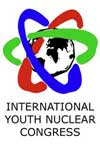
5 - 11 August 2012
Charlotte, USA
North American Young Generation
more
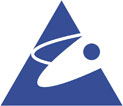
5 - 7 September 2012
Ljubljan, Slovenia
more

17 -21 September 2012
Como, Italy
more

24 -28 September 2012
Paris, France
more

10 - 13 October 2012
Hissar, Bulgaria
more

7 - 11 April 2013
Avignon, France
more
http://www.euronuclear.org/e-news/e-news-35/Member-Societies.htm

Austrian
Nuclear Society |
Belgian
Nuclear Society |
Bulgarian
Nuclear Society |
Croatian
Nuclear Society |
Czech Nuclear Society |
Finnish
Nuclear Society |
French
Nuclear Energy Society (SFEN) |
German
Nuclear Society (KTG) |
Hungarian
Nuclear Society |
The
Israel Nuclear Society |
Italian
Nuclear Association |
Lithuanian
Nuclear Energy Association |
Netherlands Nuclear Society |
The Nuclear Institute |
Nuclear
Society of Russia |
Nuclear
Society of Serbia |
Nuclear
Society of Slovenia |
Polish
Nuclear Society |
Romanian
Nuclear Energy Association (AREN) |
Slovak
Nuclear Society |
Spanish
Nuclear Society |
Swedish
Nuclear Society |
Swiss
Nuclear Society |
http://www.euronuclear.org/e-news/e-news-35/Corporate-Members.htm
Links to ENS Corporate Members |
AF-Colenco Ltd., Nuclear Technology
Department |
Alpiq Ltd |
Alpiq Suisse Ltd. |
Andritz AG |
Ansaldo Nucleare S.p.A |
AREVA NP |
AREVA NP GmbH |
Atomic Energy Council (AEC) |
Atomic Energy of Canada Limited (AECL) |
Atomexpo LLC |
Atomtex SPE |
Axpo AG |
BKW FMB Energie AG |
Chilean Nuclear Energy Commisssion |
CCI AG (formerly Sulzer Thermtec Ltd) |
Design Bureau "Promengineering" |
NV Elektriciteits-Produktiemaatschappij
Zuid-Nederland EPZ (Electricity Generating Co. Ltd in the
Southern Netherlands) |
E.O.N Kernkraft GmbH |
Euro Nuclear Services BV |
Electrabel, Generation Department |
Electricité de France (EDF), Communication Division |
ENUSA Industrias Avanzadas SA |
EXCEL Services Corporation |
GE Nuclear Energy |
IEA of Japan Co. Ltd |
Japan Electric Power Information Center (JEPIC) link |
Kernkraftwerk Gösgen-Däniken
AG |
Kernkraftwerk Leibstadt AG (KKL), |
L-3 Communications MAPPS Inc. |
Linn High Therm GmbH |
Elektroinstitut Milan Vidmar |
NRG Arnhem |
NRG Petten |
NUKEM Technologies GmbH |
ONET TECHNOLOGIES |
Paks Nuclear Power Plant Ltd |
Paul Scherrer Institute |
Polimaster Ltd |
Siempelkamp Nukleartechnik
GmbH |
|
SKB (Swedish Nuclear Fuel and Waste Management
Company) |
Studiecentrum voor Kernenergie, Centre d’Etude
de l’Energie Nucléaire SCK/CEN |
Synatom |
Taiwan Atomic Energy Council (AEC) |
Taiwan Power Company (Taipower) |
"Technoatomenergo" Close Joint-Stock
Company |
Teollisuuden Voima Oyj / Industrial Power
Company Ltd (TVO) |
Tractebel Engineering S. A. |
UNESA |
Urenco Limited |
Vattenfall AB |
VNS – Vinçotte Nuclear Safety |
VTT Nuclear |
Westinghouse Electric Company |
World Association of Nuclear Operators
(WANO), |
|
http://www.euronuclear.org/e-news/e-news-35/editorial.htm

Editorial Staff:
Mark O’Donovan, Editor-in-Chief
Contributors to this Issue:
Marko Čepin (NSS)
Kirsten Epskamp (ENS)
Raluka Fako (Romanian Authority for Nuclear Activities)
Concetta Fazio (KIT-NUKLEAR)
Fredrik Johansson (LUCOEX)
Joachim Knebel (KIT-CSO)
Marco Streit (ENS)
Christer Svemar (LUCOEX)
Andrew Teller
Jean Van Vyve (BNS)
Realisation:
Marion Brünglinghaus
Rue Belliard 65, BE-1040 Brussels
Phone +32 2 505 30 50 - Fax: +32 2 502 39 02
E-mail: info@euronuclear.org - http://www.euronuclear.org
The ENS News is a quarterly publication, in electronic
form only.
Copyright notice ©2012 European Nuclear Society.
Reproduction is authorised provided that the ENS News is acknowledged as the
source – except where otherwise stated.
![]()
© European Nuclear Society, 2012